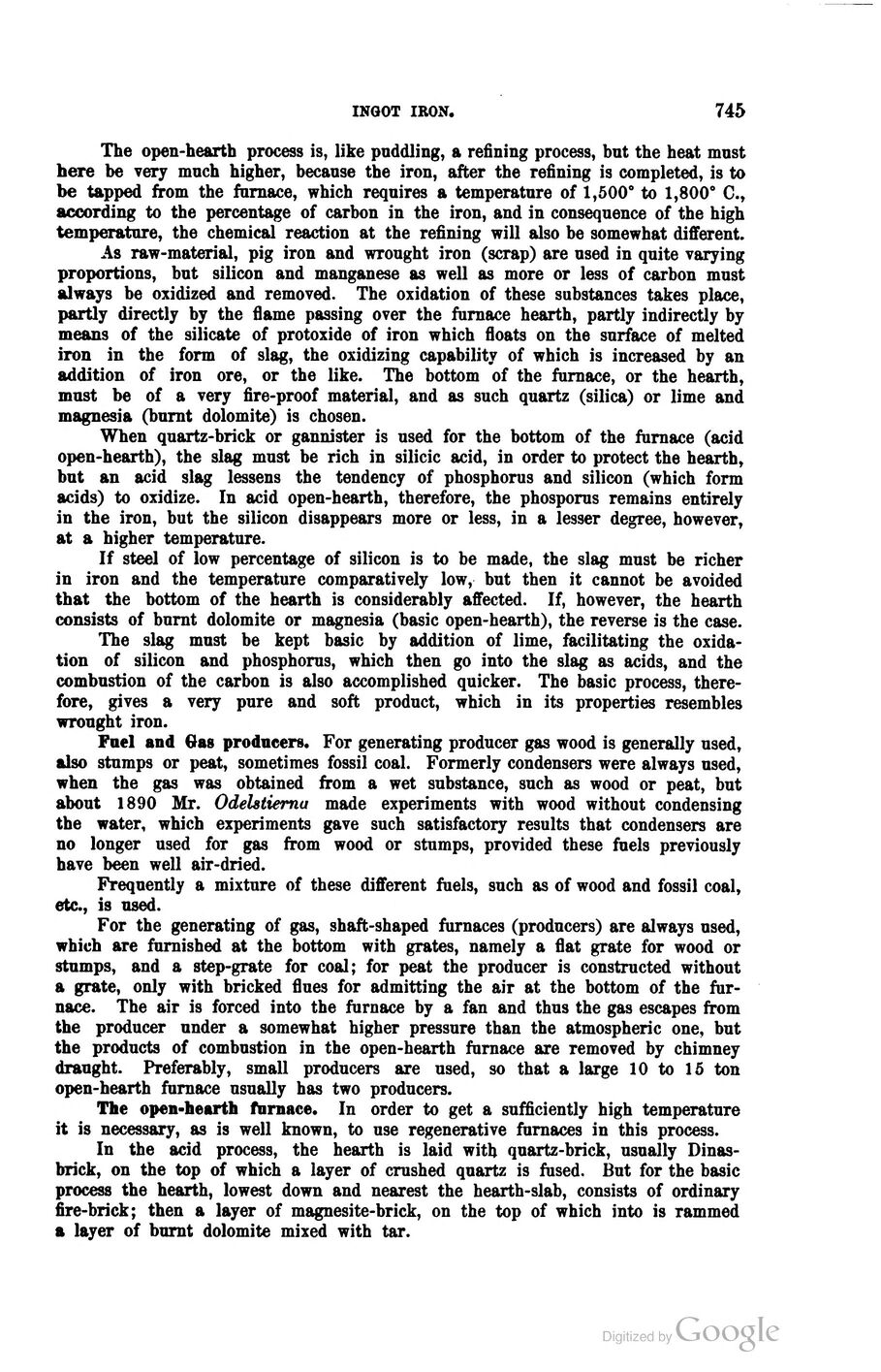
Full resolution (JPEG) - On this page / på denna sida - Second part - IX. Mining Industry and Metal Production - 2. The Iron and Steel Industry. By the late Prof. J. G. Wiborgh - Ingot iron (Steel)

<< prev. page << föreg. sida << >> nästa sida >> next page >>
Below is the raw OCR text
from the above scanned image.
Do you see an error? Proofread the page now!
Här nedan syns maskintolkade texten från faksimilbilden ovan.
Ser du något fel? Korrekturläs sidan nu!
This page has never been proofread. / Denna sida har aldrig korrekturlästs.
wrought iron.
745
The open-hearth process is, like puddling, a refining process, but the heat must
here be very much higher, because the iron, after the refining is completed, is to
be tapped from the furnace, which requires a temperature of 1,500° to 1,800° C.,
according to the percentage of carbon in the iron, and in consequence of the high
temperature, the chemical reaction at the refining will also be somewhat different.
As raw-material, pig iron and wrought iron (scrap) are used in quite varying
proportions, but silicon and manganese as well as more or less of carbon must
always be oxidized and removed. The oxidation of these substances takes place,
partly directly by the flame passing over the furnace hearth, partly indirectly by
means of the silicate of protoxide of iron which floats on the surface of melted
iron in the form of slag, the oxidizing capability of which is increased by an
addition of iron ore, or the like. The bottom of the furnace, or the hearth,
must be of a very fire-proof material, and as such quartz (silica) or lime and
magnesia (burnt dolomite) is chosen.
When quartz-brick or gannister is used for the bottom of the furnace (acid
open-hearth), the slag must be rich in silicic acid, in order to protect the hearth,
but an acid slag lessens the tendency of phosphorus and silicon (which form
acids) to oxidize. In acid open-hearth, therefore, the phosporus remains entirely
in the iron, but the silicon disappears more or less, in a lesser degree, however,
at a higher temperature.
If steel of low percentage of silicon is to be made, the slag must be richer
in iron and the temperature comparatively low, but then it cannot be avoided
that the bottom of the hearth is considerably affected. If, however, the hearth
consists of burnt dolomite or magnesia (basic open-hearth), the reverse is the case.
The slag must be kept basic by addition of lime, facilitating the
oxidation of silicon and phosphorus, which then go into the slag as acids, and the
combustion of the carbon is also accomplished quicker. The basic process,
therefore, gives a very pure and soft product, which in its properties resembles
wrought iron.
Fuel and Gas producers. For generating producer gas wood is generally used,
also stumps or peat, sometimes fossil coal. Formerly condensers were always used,
when the gas was obtained from a wet substance, such as wood or peat, but
about 1890 Mr. Odehtiernu made experiments with wood without condensing
tbe water, which experiments gave such satisfactory results that condensers are
no longer used for gas from wood or stumps, provided these fuels previously
have been well air-dried.
Frequently a mixture of these different fuels, such as of wood and fossil coal,
etc., is used.
For the generating of gas, shaft-shaped furnaces (producers) are always used,
which are furnished at the bottom with grates, namely a fiat grate for wood or
stumps, and a step-grate for coal; for peat the producer is constructed without
a grate, only with bricked flues for admitting the air at the bottom of the
furnace. The air is forced into the furnace by a fan and thus the gas escapes from
the producer under a somewhat higher pressure than the atmospheric one, but
the products of combustion in the open-hearth furnace are removed by chimney
draught. Preferably, small producers are used, so that a large 10 to 15 ton
open-hearth furnace usually has two producers.
The open-hearth furnace. In order to get a sufficiently high temperature
it is necessary, as is well known, to use regenerative furnaces in this process.
In the acid process, the hearth is laid with quartz-brick, usually
Dinas-brick, on the top of which a layer of crushed quartz is fused. But for the basic
process the hearth, lowest down and nearest the hearth-slab, consists of ordinary
fire-brick; then a layer of magnesite-brick, on the top of which into is rammed
a layer of burnt dolomite mixed with tar.
<< prev. page << föreg. sida << >> nästa sida >> next page >>